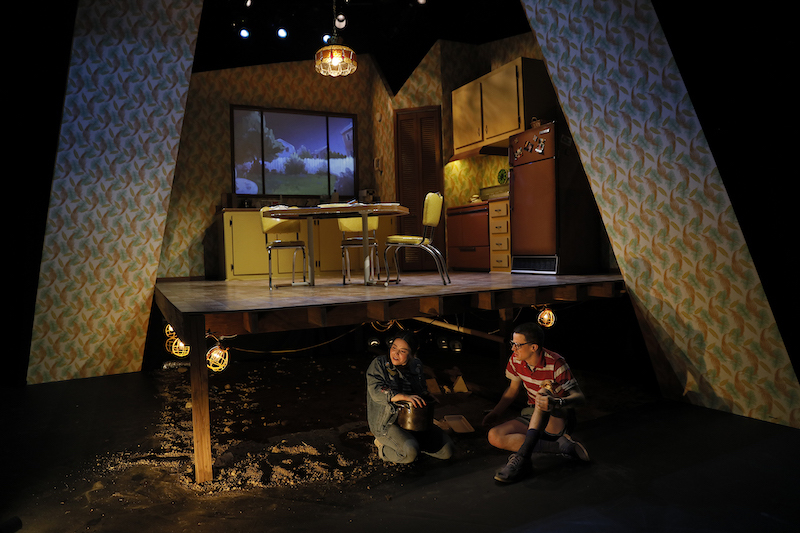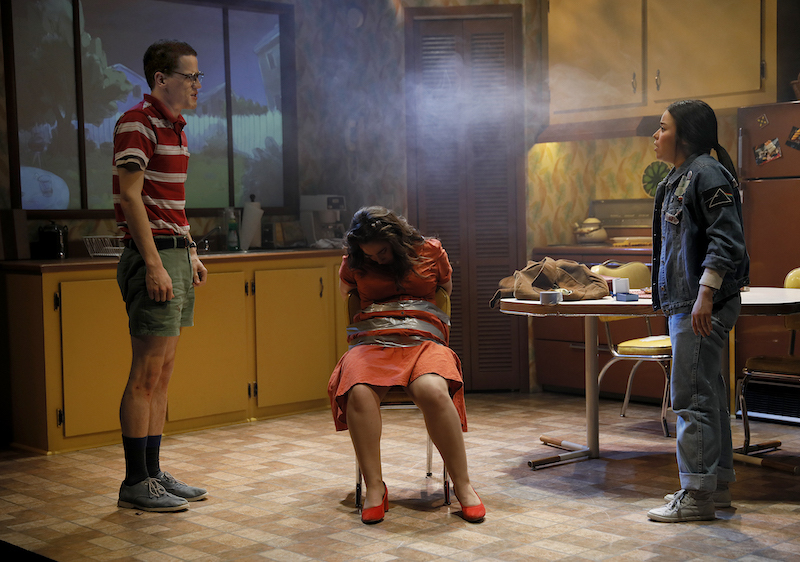Feathers And Teeth: Horror With Rotten Messages
Review of Feathers and Teeth presented by Washington Ensemble Theatre.
Written by Francesca Vinci during TeenTix’s Theater & Dance Press Corps Intensive.

Feathers and Teeth is a short play with a small cast delving into ideas of grief, madness, and manipulation. A delusional daughter, a manipulative stepmother, and an oblivious father take the stage around a mysterious death and supernatural beasties—but what does it mean?
Created by Charise Castro Smith and directed by Bobbin Ramsey, the play centers around thirteen year old Chris, her father Arthur, and her stepmother Carol. Chris is convinced that Carol, her deceased mother’s hospice nurse, is a demon, while Arthur sees no substance in his daughter’s accusations. The wonderfully designed set by Pete Rush and the lighting design by Ryan Dunn pull the piece together, but the overall meaning of the play is ambiguous at best.
The set (designed by Pete Rush) may have been the best part of the play. It centers around a 70s kitchen, complete with bright yellow vinyl chairs, bottles of aerosol cleaners, and a fridge that looked like it was straight out of my grandmother’s basement. The props in the set (managed by Robin Macartney) really made the set stand out as extraordinary—the kitchen counters were covered in knick knacks you might find in a real kitchen—dirty dishes, paper towel rolls, and all the other things more minimalistic sets leave out. It served to make the scenes much more realistic.

Underneath the floor of the kitchen, there was a crawl space in which some of the play took place: it was covered with dirt and caged light bulbs served as the only illumination of this part of the set. The two-layer set was an interesting concept that worked well with the play, making it able to see two separate things going on at once. This served for a wonderful backdrop for a show not too scary, but just scary enough.
Feathers and Teeth brought a pleasing balance of horror, but not scary enough that you could not handle it. The wonderfully dark themes of the play and the sometimes gory, but not quite graphic, depictions of violence let your mind work out just exactly what was happening behind closed doors. For example, in one scene you can hear someone being eaten, and see their bones brought out of the closet later, but it’s up to your own imagination to decide exactly what happened to reduce the character to a pile of bones. In some ways, that can be even scarier, in a philosophical sort of way: the agony of not knowing can be even more terrifying than the actual events. But in terms of message, the show gives no clear pointers as to what it’s really about.
Throughout the play and through the next day, I struggled to find a meaning hidden between the lines of Feathers and Teeth. I thought about the dynamic between stepmother Carol (Samie Spring Detzer) and deranged daughter Chris (Rachel Guyer-Mafune), and even tried to find meaning through the legends of the Teufel described by Chris’ German friend Hugo (James Schilling). But any meaning that could be extracted from the play seems to do more harm than good: that women are inherently manipulative? That grieving, insane children are right in their unsupported accusations?

Both Chris and Carol are seen manipulating the men in the play: Chris kisses her dad in one scene to get him to stop yelling at her, and Carol brainwashes Arthur (the father, played by Brandon J. Simmons) to think that everything is Chris’ fault before convincing him to marry her. Chris’ insistence that Carol is a demon starts even before she has any proof, showing that at her heart she’s just a child trying to compensate for the loss of her mother by blaming those around her. What kind of message do we send when we tell those children that they’re right?
Overall, I am conflicted by the quality of the play. The lighting, set, prop design was all very well done, and the acting was superb. The costumes and hair were immaculate, and the relationships and dynamics between the characters seemed realistic and interesting. However, the meaning of the play fell short. Did it have a bad message, or did it have no message at all? The ambiguity of the meaning of the play put a damper on the rest of the elements of the play for me, and I wish I could have enjoyed it more.
Lead photo caption: Rachel Guyer-Mafune as Chris in WET's Feathers and Teeth. Photo credit: Chris Bennion.
Francesca Vinci is a 10th grader at West Seattle High School.
This review was written as part of the Theater & Dance Press Corps Intensive.
The TeenTix Press Corps promotes critical thinking, communication, and information literacy through criticism and journalism practice for teens. For more information about other Press Corps programs including the Teen Editorial Staff or the TeenTix Newsroom, see HERE.

